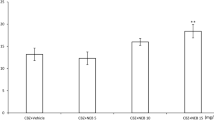Summary
CR 2039 [4-(1H-tetrazol-5-yl)-N-(4-(1H-tetrazol-5-yl]phenylbenzamide], in doses of 10, 50, and 100mg/kg i.p., significantly elevated the threshold for electroconvulsions, increasing the CS50 (current strength 50% in mA) values from 6.3 to 7.2, 7.5, and 7.6 mA, respectively. When combined with carbamazepine, diphenylhydantoin, or valproate, CR 2039 (5 and 10mg/ kg) potentiated the anticonvulsive action of these antiepileptics against maximal electroshock-induced convulsions which was reflected by significant decreases in the respective ED50s (in mg/kg). The protective efficacy of phenobarbital was not affected by the phenylbenzamide derivative. The potentiation of the anticonvulsive activity of three antiepileptics was not accompanied by increased adverse effects, evaluated in the chimney test (motor coordination) and passive avoidance task (long-term memory). Finally, CR 2039 (10 mg/kg) did not alter the plasma levels of the antiepileptic drugs studied which speaks against a pharmacokinetic mechanism in the observed results.
It is concluded that CR 2039 may prove a safer anti-asthmatic drug for the use in epileptic patients than aminophylline which, either acutely or chronically, considerably impaired the anticonvulsive activity of conventional antiepileptics.
Similar content being viewed by others
References
Boissier JR, Tardy J, Diverres JC (1960) Une nouvelle methode simple pour explorer l'action “tranquilisante”: le test de la cheminee. Med Exp (Basel) 3: 81–84
Borowicz KK, Kozicka M, Kleinrok Z, Czuczwar SJ (1993) Influence of aminophylline and 8-(p-sulfophenyl)theophylline on the anticonvulsive action of diphenylhydantoin, phenobarbital, and valproate against maximal electroshock-induced convulsions in mice. J Neural Transm [GenSect] 93: 157–163
Borowicz KK, Gasior M, Kleinrok Z, Czuczwar SJ (1995) The non-competitive AMPA/kainate receptor antagonist, GYKI 52466, potentiates the anticonvulsant activity of conventional antiepileptics. Eur J Pharmacol 281: 319–326
Czechowska G, Dziki M, Pietrasiewicz T, Kleinrok Z, Turski WA, Kleinrok Z (1993) Competitive antagonists of NMDA receptors, CGP 37849 and CGP 39551, enhance the anticonvulsant activity of valproate against electroconvulsions in mice. Eur J Pharmacol 232: 59–64
Czuczwar SJ, Turski WA, Ikonomidou C, Turski L (1985) Aminophylline and CGS 8216 reverse the protective action of diazepam against electroconvulsions in mice. Epilepsia 26: 693–696
Czuczwar SJ, Ikonomidou C, Kleinrok Z, Turski WA (1986) Effect of aminophylline on the protective action of common antiepileptic drugs against electroconvulsions in mice. Epilepsia 27: 204–208
Czuczwar SJ, Jäckel R, Löscher W (1987a) Effects of aminophylline and enprofylline on the protective activity of phenobarbital against amygdala-kindled seizures in rats. Epilepsy Res 1: 234–238
Czuczwar SJ, Kleinrok Z, Turski L, Turski WA (1987b) Effect of aminophylline and enprofylline on the protective efficacy of common antiepileptic drugs against electroconvulsions in mice. Epilepsia 28: 383–386
Czuczwar SJ, Janusz W, Szczepanik B, Wamil A, Kleinrok Z (1989) Effect of aminophylline upon the protective activity of common antiepileptic drugs and their plasma levels in mice. Neurosci Res 6: 470–474
Litchfield JT, Wilcoxon F (1949) A simplified method of evaluating dose-effect experiments. J Pharmacol Exp Ther 96: 99–113
Pietrasiewicz T, Czechowska G, Dziki M, Turski WA, Kleinrok Z, Czuczwar SJ (1993) Competitive NMDA receptor antagonists enhance the antielectroshock activity of various antiepileptics. Eur J Pharmacol 250: 1–7
Revel L, Colombo S, Ferrari F, Folco G, Rovati LC, Makovec F (1992) CR 2039, a new bis-(1H-tetrazol-5-yl)phenylbenzamide derivative with potential for the topical treatment of asthma. Eur J Pharmacol 229: 45–53
Serafin WE (1996) Drugs used in the treatment of asthma. In: Hardman JG, Limbird LE, Molinoff PB, Ruddon RW, Goodman Gilman A (eds) The pharmacological basis of therapeutics, 9th ed. McGraw-Hill, New York, pp 659–682
Singer EP, Kolischenko A (1985) Seizures due to aminophylline overdose. Chest 87: 755–757
Ukena D, Sybrecht R (1990) Management of chronic airway obstruction: theophylline — is it still necessary? Lung [Suppl]: 127–134
Venault P, Chapouthier G, De Carvalho LP, Simiand J, Morre M, Dodd RH, Rossier J (1986) Benzodiazepines impair and beta-carbolines enhance performance in learning and memory task. Nature 321: 864–866
Wlaź P, Roliński Z, Kleinrok Z, Czuczwar SJ (1992) Anticonvulsant activity of carbamazepine and diphenylhydantoin against maximal electroshock in mice chronically treated with aminophylline. J Neural Transm [GenSect] 89: 41–48
Wlaź P, Roliński Z, Kleinrok Z, Czuczwar SJ (1993) Influence of chronic aminophylline on the anticonvulsant efficacy of phenobarbital and valproate in mice. Epilepsia 34: 385–389
Wlaź P, Roliński Z, Kleinrok Z, Czuczwar SJ (1994) Influence of chronic aminophylline on antielectroshock activity of diazepam and aminophylline-induced convulsions in mice. Pharmacol Biochem Behav 49: 609–613
Yarnell PR, Chu N-S (1975) Focal seizures and aminophylline. Neurology 25: 819–822
Zwillich CW, Sutton FD, Neff TA, Cohn WM, Matthay RA, Weinberger MM (1975) Theophylline-induced seizures in adults: correlation with serum concentrations. Ann Intern Med 82: 784–787
Żarnowski T, Kleinrok Z, Turski WA, Czuczwar SJ (1993) 2,3-Dihydroxy-6-nitro-7-sulfamoylbenzo(F)quinoxaline enhances the protective activity of common antiepileptic drugs against maximal electroshock-induced seizures in mice. Neuropharmacology 32: 895–900
Author information
Authors and Affiliations
Rights and permissions
About this article
Cite this article
Czuczwar, S.J., Gasior, M., Kozicka, M. et al. Influence of a potential anti-asthmatic drug, CR 2039, upon the anticonvulsive activity of conventional antiepileptics against maximal electroshock-induced seizures in mice. J. Neural Transmission 103, 1371–1379 (1996). https://doi.org/10.1007/BF01271251
Received:
Accepted:
Issue Date:
DOI: https://doi.org/10.1007/BF01271251




